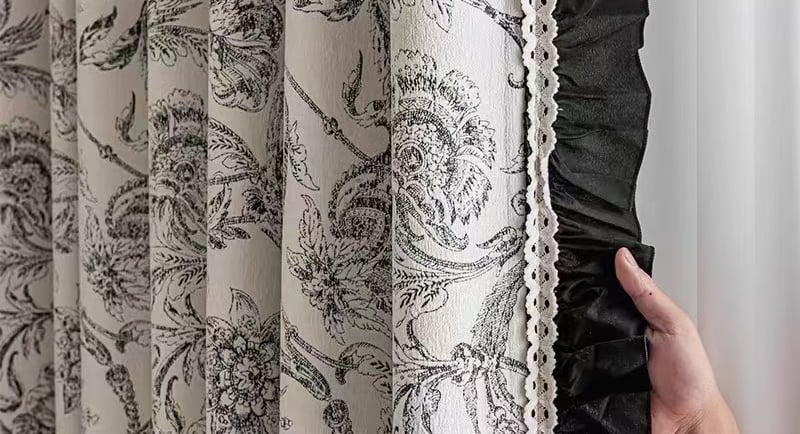The Rise of E-Commerce and Its Effect on the Curtain and Fabric Sales Landscape
11/30/20245 min read


Understanding E-Commerce Growth
The growth of e-commerce has been staggering in recent years, reshaping the retail landscape and the way consumers approach shopping. Statistically, e-commerce sales are projected to reach $6.3 trillion globally by the end of 2023, indicating a significant shift from traditional retail channels. This rapid expansion is attributed to several key factors that are not only enhancing consumer experiences but also driving purchases across various sectors, including curtains and fabric sales.
One major factor contributing to the rise of e-commerce is the advancement of technology. The proliferation of smartphones and high-speed internet access has made online shopping more accessible than ever. Websites and mobile applications now offer user-friendly interfaces, making it easier for people to browse and purchase products from the comfort of their homes. Additionally, emerging technologies such as augmented reality (AR) and artificial intelligence (AI) are enhancing online shopping by allowing consumers to visualize products, such as curtains and fabrics, in their own spaces before making a purchase.
Another critical element influencing e-commerce growth is the changing consumer preferences. Modern shoppers increasingly favor the convenience of online purchases over traditional brick-and-mortar shopping. Factors such as personalized recommendations, competitive pricing, and the ability to compare products easily contribute to a more enticing shopping experience. Furthermore, the surge in home improvement projects during the COVID-19 pandemic made consumers more inclined to explore online options for home decor, boosting curtain and fabric sales significantly.
To summarize, the growth of e-commerce continues to redefine consumer behavior through technological advancements and evolving preferences. As this trend progresses, its implications on niche markets, including curtains and fabric sales, will become even more pronounced, underscoring the need for retailers to adapt to this shifting landscape.
Impact on Curtain and Fabric Sales
The advent of e-commerce has undeniably transformed the landscape of curtain and fabric sales, significantly altering consumer purchasing habits. As more shoppers turn to the internet for their shopping needs, the traditional brick-and-mortar retail model is witnessing a decline in foot traffic. Consumers are now increasingly inclined to browse, evaluate, and purchase curtains and fabrics from the comfort of their homes. This shift towards online shopping is facilitated by several factors, including convenience, variety, and often, competitive pricing.
One of the most profound changes observed is the expanded market reach for fabric retailers who embrace e-commerce. Online platforms enable sellers to showcase their products to a broader audience beyond geographic limitations. Local retailers, once confined to their immediate communities, now compete with national and global online players. This democratization of retail access allows niche fabric sellers to thrive by reaching specific segments of consumers who require specialized offerings. However, it also amplifies competition, creating challenges for those less equipped to navigate this digital landscape.
Furthermore, established fabric retailers must now prioritize a robust online presence to maintain market relevance. This involves not only creating an appealing and user-friendly website but also optimizing it for search engines to ensure visibility. High-quality product images, detailed descriptions, and customer reviews are essential in facilitating informed purchasing decisions and enhancing customer trust. Social media platforms further serve as critical channels for engagement and promotion, allowing retailers to build brand loyalty and reach a curated audience.
While e-commerce presents numerous benefits, it also brings challenges, such as managing logistics, ensuring product quality, and providing exemplary customer service. Thus, fabric retailers must adapt strategically, balancing the advantages of an online shopping environment while addressing the inherent hurdles. The rise of e-commerce continues to reshape the curtain and fabric sales market, prompting ongoing innovation in how these products are marketed and sold.
Consumer Behavior and Preferences
The advent of e-commerce has significantly transformed consumer behavior, particularly in the realm of curtain and fabric sales. One of the hallmark changes is the increasing demand for customization. Consumers today seek tailored solutions that reflect their individual style preferences. Online platforms enable brands to offer personalized options, such as custom colors, patterns, and sizes, allowing shoppers to create unique designs that suit their specific needs. This shift toward customization underscores a broader trend where buyers favor products that resonate with their personal taste.
Furthermore, the accessibility of a wider range of products through online shopping has empowered consumers to explore possibilities beyond local offerings. With just a few clicks, shoppers can access countless brands and styles from different parts of the world. This expansion leads to more informed consumers who are better equipped to compare products, prices, and quality. Such exposure allows for an enhancement of decision-making skills, resulting in more discerning shoppers that prioritize value and functionality in their purchases.
The role of review systems has also emerged as a critical component influencing purchasing decisions. Shoppers frequently rely on customer reviews and ratings to gauge the quality and performance of curtains and fabrics. This reliance on peer recommendations not only fosters trust in e-commerce but also shapes brand perceptions. The availability of detailed feedback allows potential buyers to make educated decisions, ensuring their expectations align with the actual product offerings.
Additionally, social media has become a pivotal channel for the discovery and engagement of curtain and fabric brands. Online marketing tactics, including influencer collaborations and targeted advertisements, have transformed how brands connect with consumers. Social media platforms enable brands to showcase their latest collections and interact with customers in real time, thereby cultivating a community around their products. Overall, these factors illustrate a dynamic shift in consumer preferences, driven by the convenience and possibilities afforded by e-commerce.
Future Trends in E-Commerce for Curtain and Fabric Sales
The evolution of e-commerce continues to significantly shape the curtain and fabric sales landscape. With technology advancing at an unprecedented pace, several future trends can be anticipated that will further enhance the online shopping experience for consumers. A notable trend is the integration of augmented reality (AR) and artificial intelligence (AI) into e-commerce platforms. These technologies will allow customers to visualize how different curtains and fabrics will look in their space before making a purchase. AR applications can enable users to virtually place products in their homes using their smartphones, thus providing a more immersive shopping experience. This capability not only increases consumer confidence in their purchases but potentially reduces return rates associated with online fabric sales.
Additionally, AI can streamline the shopping process through personalized recommendations based on consumer behavior and preferences. By analyzing previous purchases and browsing habits, e-commerce platforms can present tailored suggestions, making it easier for customers to find fabrics and curtains that match their specific style and needs. Such advancements are likely to improve customer satisfaction and drive sales, fostering loyalty in an increasingly competitive market.
Another significant trend that is anticipated in the curtain and fabric industry is the heightened focus on environmental sustainability. As consumers become more informed and concerned about the impacts of their purchases on the planet, there is an increasing demand for eco-friendly materials and ethical manufacturing practices. Producers and retailers that prioritize sustainable sourcing and transparent supply chains could benefit from heightened consumer preference. This shift toward responsible consumption may reshape marketing strategies, with brands needing to communicate their sustainability efforts effectively to appeal to conscious consumers.
In essence, as e-commerce continues to evolve, integrating advanced technologies while embracing sustainability will be crucial for the future success of curtain and fabric sales. Businesses that adapt to these trends will be well-positioned to meet the shifting demands of today's consumers.
Curtains&Fabrics
Design,production,sales,service in curtain fabrics&curtians.
Quality
Products
sales01@anytextile.com
+8615968501933
© 2024. SHAOXING LEYAO IMPORT AND EXPORT CO.LTD All rights reserved.
